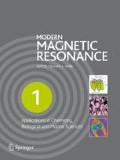Hydrogen bonding plays an important role in forming higher-order structures of peptides, polypeptides and proteins. Accordingly, the nature of the hydrogen bond has been widely studied by various spectroscopic methods. High-resolution NMR spectroscopy has been used as one of the most powerful methods for obtaining useful information on the details of the hydrogen-bonded structure.
Access this chapter
Tax calculation will be finalised at checkout
Purchases are for personal use only
Preview
Unable to display preview. Download preview PDF.
Author information
Authors and Affiliations
Editor information
Editors and Affiliations
Rights and permissions
Copyright information
© 2008 Springer
About this chapter
Cite this chapter
Kuroki, S. (2008). 13C, 15N, 1H, 2H, and 17O NMR Chemical Shift NMR for Hydrogen Bonds. In: Webb, G.A. (eds) Modern Magnetic Resonance. Springer, Dordrecht. https://doi.org/10.1007/1-4020-3910-7_3
Download citation
DOI: https://doi.org/10.1007/1-4020-3910-7_3
Publisher Name: Springer, Dordrecht
Print ISBN: 978-1-4020-3894-5
Online ISBN: 978-1-4020-3910-2
eBook Packages: Chemistry and Materials ScienceChemistry and Material Science (R0)

